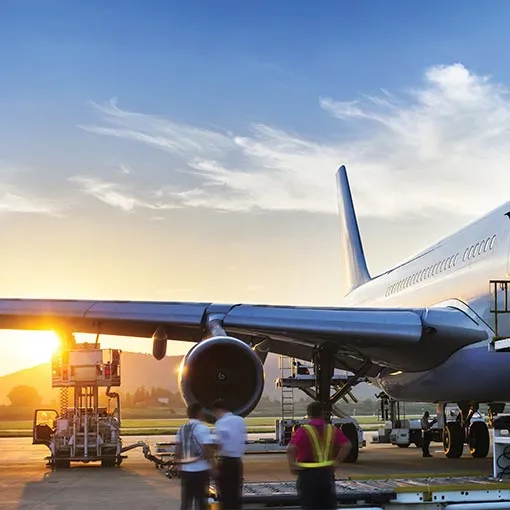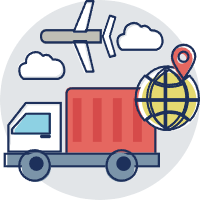When you need your goods yesterday, air freight is your best bet.
Read on to learn about how air freight works, when you should use it, and how to find the best price.

Air freight costs and international and express air freight rates per kg
1.Air cargo is used by global importers and exporters when they need to get goods somewhere quickly and reliably. While 90% of everything is shipped by ocean freight, air freight connects the world faster, cutting China-US freight shipping time from 20-30 days by ocean to only three days by air cargo.
2.International air freight and express freight shipments are not the same things.
3.Express air freight is typically handled by one company (like DHL, UPS or FedEx) that manages the entire shipment lifecycle, with shipping from door to door in under five days. Express air freight shipments are usually smaller (less than one cubic meter and 200 kilograms) than air freight. International air freight shipments can be significantly larger and may move across multiple carriers during shipment. As a matter of fact, the largest cargo airplane, the Anatov 225, can hold an entire train.
4.In a typical season, international air cargo rates can range from approximately $2.50-$5.00 per kilogram, depending on the type of cargo you’re shipping and available space. However, costs have risen sharply since February 2020 as a result of severe disruptions in ocean freight and high consumer demand.
Air freight shipping prices and costs calculation
When it comes to air freight shipping, weight and volume are key factors. Air carriers will charge by either volumetric weight (also known as dimensional weight) or actual weight, depending on which is more expensive.
To calculate volumetric weight for air shipping, multiply the item’s volume in cubic meters by 167. So, let’s say you have a package with the following measurements: W: 40cm, H: 40cm L:40. This means that the volume is .064 (the product of all sides divided by one million). Multiply this by 167 and you get a volumetric weight of 10.67 kg.
If the volumetric weight exceeds the actual weight of the product, the volumetric weight becomes the chargeable weight. For light air shipments, you can use this chargeable weight calculator to work out whether your shipment will be charged by actual weight or dimensional weight.
The benefits of air freight
There are three main benefits to shipping by air:
Speed – Airplanes are about 30 times faster than ocean liners. Passenger jets cruise at 575 mph, while slow-steaming ocean liners move at 16-18 mph. That means an air freight shipment can take merely five days from a factory in China to a warehouse in the United States. Use this transit time calculator, based on data from real recent shipments to get estimates of transit times for air shipping.
Reliability – Shipping by air provides better tracking and greater certainty that your goods will get to the right place at the right time.
Protection – Goods are more likely to be damaged when traveling by ocean freight shipping than by air shipping. This makes it a good option for fragile items.
When shouldn’t I ship by air?
Here are some of the drawbacks to shipping by air:
Cost – Air freight comes with a hefty price tag compared to ocean freight. Comparing air and ocean freight, a medium size 2000 lbs box from Shenzhen, China to Los Angeles, USA, can cost $1,500 by ocean but a whopping $8,000 or more by air. However, with currently elevated ocean costs, this difference may be lower.
CO2 emissions – Air freight leads to far more emissions. For example, according to UK government research, 2 tons shipped for 5,000 kilometers by ocean will lead to 150 kg of CO2 emissions, compared to 6,605 kg of CO2 emissions by air. Definitely not the greenest way to ship.
Heavy shipments – Ever since the 1960s, freight shipping has revolved around shipping containers, which are great for shipping large, heavy items. Air freight is priced based on both size and weight, which can scale price very quickly.
What goods are generally shipped via air freight?
Since air cargo rates are expensive, it’s usually limited to smaller, high-value goods or time-sensitive items, such as:
Electronics. Steve Jobs famously purchased the entire available air freight capacity along key Asia-US routes to ship the first iMac prior to the holiday season.
Apparel. Seasonal trends in clothing can shift fast. As a result, companies generally need to move clothing from factories to stores as quickly as possible. Clothing’s small size and high value additionally make air freight a worthwhile expense.
Pharmaceuticals. Given their small size and value, medical goods are frequently shipped by air.
Documents and samples. DHL Global Forwarding actually got started by shipping ocean freight documents by air to expedite release along a new West Coast-Hawaii ocean line. Air remains the most cost-effective method of shipping documents.
Seasonal shipments. Whatever the product is, if there’s high international demand for a product that requires bolstering down a supply chain, it will generally be shipped by air.
Air freight shipping rates & charges
Beyond the expense of air freight, which is calculated based on the cost above, the total cost to ship by air will also likely include:
Fuel surcharges
Security surcharges
Container freight station/terminal handling charges
Airport transfers
In addition, for door-to-door costs, the price will also include air cargo services, including:
Customs brokerage
Pickup and delivery
Cargo insurance
Accessorial charges




















